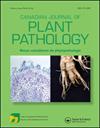Understanding the root rot and wilting complex of raspberry: current research advances and future perspectives
IF 1.5
4区 农林科学
Q3 PLANT SCIENCES
引用次数: 4
Abstract
Abstract Red raspberry (Rubus idaeus L.) is an important fruit crop in British Columbia, Canada, and the Pacific Northwest (PNW) region of the USA, as well as in other regions of the world. Root rot and wilting complex (RRWC), primarily caused by Phytophthora rubi, is the most important biotic constraint responsible for declining raspberry production in these regions, causing millions of dollars in losses. Other root-infecting fungal species and the root lesion nematode (Pratylenchus penetrans) may also be found associated with the disease complex. The average lifespan of raspberry plantings in the PNW is 10 to 12 years, which is reduced to 5 years by the disease complex. Phytophthora spp. play a predominant role in the RRWC complex due to the persistent nature of oospores, rapid dispersal of inoculum, and the polycyclic nature of infection, all of which increase disease severity. In this review, we discuss the current understanding of Phytophthora spp. and other pathogens associated with the RRWC, including pathogen biology and the disease cycle, the impact of infection on the plant, as well as current and potential cultural, biological, and chemical options for management. In addition, we discuss breeding efforts for disease resistance, including conventional and molecular approaches to identify sources of resistance, molecular markers linked to potential resistance genes, and their incorporation into elite breeding materials or cultivars. We also present the current gaps in knowledge, unique challenges, and future perspectives in sustainable disease management of this important disease complex.了解树莓根腐和萎蔫复合物:当前研究进展和未来展望
摘要红树莓(Rubus idaeus L.)是加拿大不列颠哥伦比亚省、美国西北太平洋地区以及世界其他地区的重要果树。根腐和枯萎复合体(RRWC)主要由红疫霉引起,是导致这些地区树莓产量下降的最重要的生物制约因素,造成数百万美元的损失。其他根感染真菌物种和根损伤线虫(Pratylenchus pentrans)也可能与该疾病复合物有关。在PNW,树莓种植的平均寿命为10至12年,由于疾病的复杂性,这一寿命缩短至5年。疫霉菌由于卵孢子的持久性、接种物的快速扩散和感染的多环性,在RRWC复合体中发挥着主要作用,所有这些都会增加疾病的严重程度。在这篇综述中,我们讨论了目前对疫霉菌属和其他与RRWC相关的病原体的理解,包括病原体生物学和疾病周期,感染对植物的影响,以及目前和潜在的培养、生物和化学管理选择。此外,我们还讨论了抗病育种工作,包括鉴定抗性来源的常规和分子方法、与潜在抗性基因相关的分子标记,以及将其纳入优良育种材料或品种中。我们还介绍了目前在这一重要疾病综合体的可持续疾病管理方面的知识差距、独特挑战和未来前景。
本文章由计算机程序翻译,如有差异,请以英文原文为准。
求助全文
约1分钟内获得全文
求助全文
来源期刊
CiteScore
4.50
自引率
5.00%
发文量
56
审稿时长
6-12 weeks
期刊介绍:
Canadian Journal of Plant Pathology is an international journal which publishes the results of scientific research and other information relevant to the discipline of plant pathology as review papers, research articles, notes and disease reports. Papers may be submitted in English or French and are subject to peer review. Research articles and notes include original research that contributes to the science of plant pathology or to the practice of plant pathology, including the diagnosis, estimation, prevention, and control of plant diseases. Notes are generally shorter in length and include more concise research results. Disease reports are brief, previously unpublished accounts of diseases occurring on a new host or geographic region. Review papers include mini-reviews, descriptions of emerging technologies, and full reviews on a topic of interest to readers, including symposium papers. These papers will be highlighted in each issue of the journal and require prior discussion with the Editor-in-Chief prior to submission.

 求助内容:
求助内容: 应助结果提醒方式:
应助结果提醒方式:


